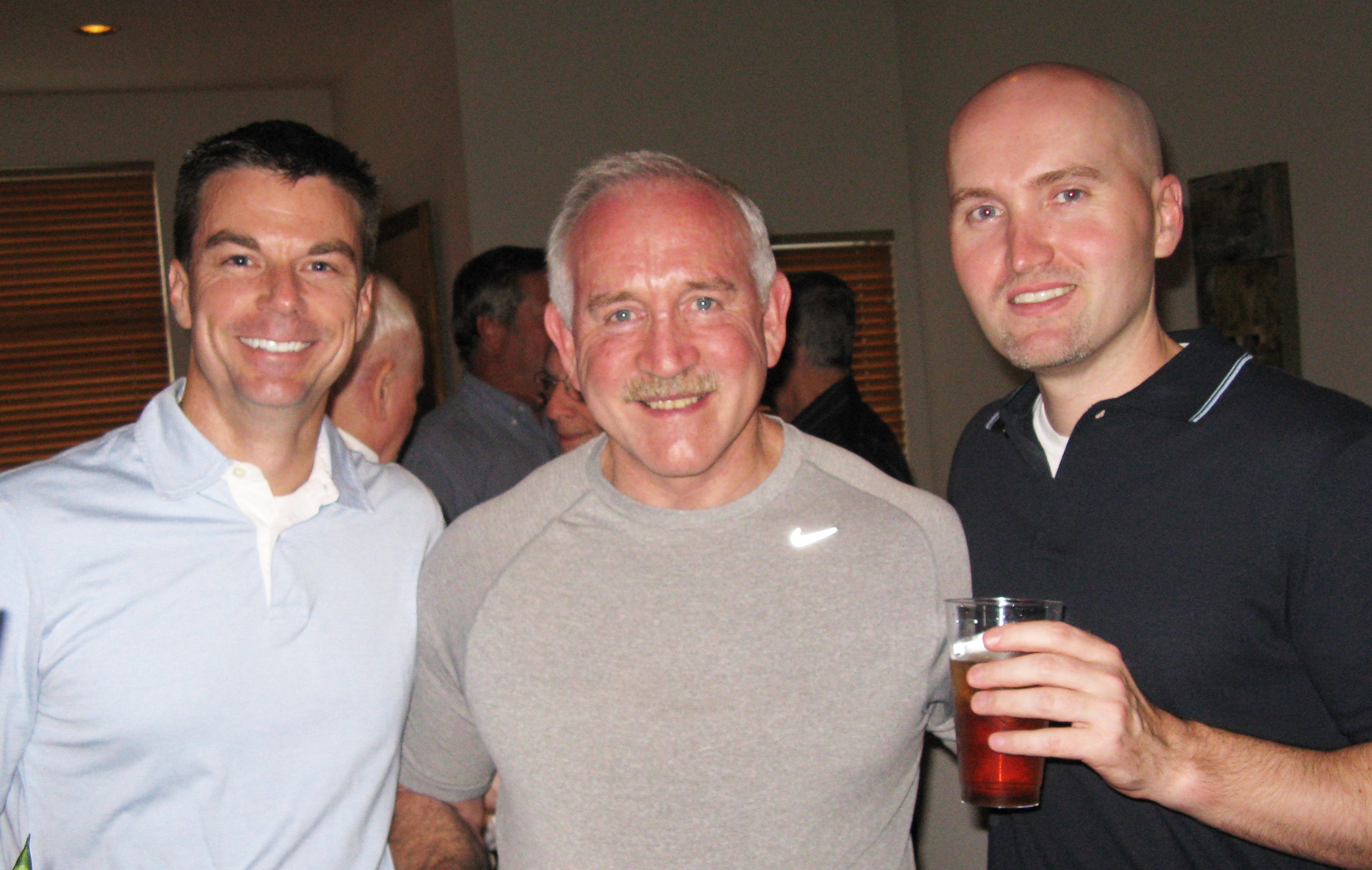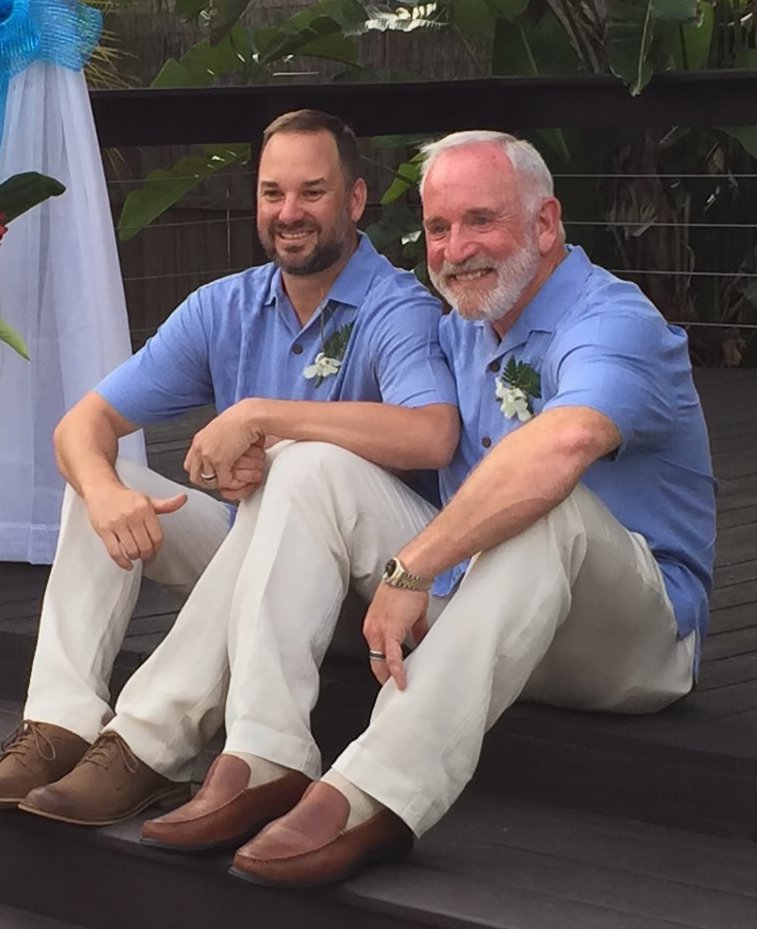By Lori Salazar
Born in Beaumont, Texas, Dr. Brady Allen graduated from the University of Texas in 1975 and attended the University of Texas Southwestern Medical School to become a doctor. After graduating fourth in his class of two hundred at Southwestern, Dr. Allen got an internship and residency at Yale. Although Dr. Allen married a high school sweetheart when he was in med school, he knew he was gay and divorced on good terms, knowing he didn’t want to hide his true identity in his personal life. In August 1981, Dr. Allen moved to Dallas with his first partner and worked at a private practice after finishing his residency. Dr. Allen laughed saying that “I was heterosexual when I was in med school, I thought, and was homosexual when I returned.”
When Dr. Allen joined a Jewish internist in Dallas, he didn’t tell him at first that he was gay since he wasn’t yet comfortable coming out professionally and feared he wouldn’t be hired. Dr. Allen worked with the internist for over three years in the general practice of internal medicine, although within the Dallas gay community he was open about his identity. In the early eighties, he began to see a lot of gay men become ill with fevers, swollen lymph glands, weight loss, and purple lesions on their body, later known as HIV/AIDS. Since Dallas had a large gay community, Dr. Allen felt as though he inherited these men as patients. One day the internist asked him, “What’s going on with you?” Dr. Allen admitted to him that he was gay, gaining the courage to come out professionally for the first time. Unfortunately, the internist told him “Well, I don’t think the Jewish community can handle this,” and asked him to leave his employment. Dr. Allen proved his boss wrong. Once he set up his own practice, he was able to retain a lot of his previous patients from the internist’s practice.
In 1985, Dr. Allen set up his own medical practice as a general internist with an HIV focus. He recalls how hard it was to treat HIV in the early eighties because there was no safe and effective treatment, adding that there was a great deal of fear and stigma attached to individuals who contracted HIV/AIDS. Dr. Allen says that other medical professionals were afraid to treat patients with HIV and didn’t even want to bring food to their hospital rooms because they were afraid of catching this unknown disease. Around 1983, when accurate blood tests became available for individuals with HIV/AIDS, the medical world was able to understand that the virus was not casually transmitted but could clearly be transmitted through sexual contact. Dr. Allen recalls that until effective treatment was available in 1995, he lost a lot of friends, colleagues, and associates from HIV/AIDS. He recalls that he felt like a hospice physician who would be holding hands and helping people die with dignity at home because there were no effective forms of treatment. Dr. Allen discussed how he attended an HIV support group for around ten years to help others in the medical profession to deal with burnout and how to deal with the large number of patients and even doctors who had died from HIV/AIDS.
Dr. Allen was involved in some of Dallas’s clinical trials for early medications to treat HIV, such as Zidovudine (AZT) and DDI (Didanoisine). When DDI was approved, he and other medical professionals were disappointed to learn that it only worked for a short time. The medical field eventually learned that it would take a combination of three different drugs to effectively treat HIV. He stated, “We did not know we had to hit the virus at three different points in the viral life cycle to stop total replication.”
Dr. Allen was also well acquainted with Ronald Woodroof, the founder of the “Dallas Buyer’s Club”. Woodroof also wanted to help find treatments for patients with HIV and AIDS, and Dr. Allen was supportive of the Dallas Buyer’s Club because they knew that the drugs Woodroof was importing to Dallas where non-toxic and inexpensive. Dr. Allen also knew they didn’t work. He said that they provided something medical professionals at the time couldn’t provide for HIV and AIDS patients, which was a sense of hope. Dr. Allen commented that the Dallas Buyer’s Club was still a success because, eventually, many of these patients were able to bridge into effective therapy when it was available in the mid-nineties. Dr. Allen regrets that so many of his patients died while consuming those early experimental drugs, not because of the side effects of the early medications, but rather because they simply didn’t work to treat the underlying disease. AZT, a drug shown to help reduce replication of the HIV/AID’s virus, was toxic, and because medical professionals didn’t realize they needed to treat the virus with three different drugs, they were over-prescribing their dosages of AZT in the hope of extending the patient’s life.
Around 1995, Dr. Allen and other medical professionals learned that they needed to combine ritonavir with AZT or DDI and 3CT to create the first effective treatment against HIV and AIDS. Dr. Allen analyzed their patients’ viral loads, and, if their viral loads became undetectable, they knew this combination of drugs was likely the key to successful treatment. He also found out that if his patients’ T-cell counts remained at around 200, they were less likely to get sick. In the mid-nineties, Dr. Allen says that, although they couldn’t find a cure to HIV and AIDS, with this triple combination therapy, patients were able to achieve a form of remission from the deadly disease.
(Left to right) Casey Wilcox, Dr. Brady Allen, and Dr. David Lee
Dr. Allen worked for clinical trials for HIV/AIDS medications and treatments, saying that if someone wanted to enter a clinical trial, they had to meet specific criteria. He documented how patients for clinical trials had to have certain T-cell counts, a certain viral load, and other criteria. He said that patients had to get screened by a PA, MP, or doctor through protocol at a private facility like the Parkland AIDS Clinic to get into a clinical trial and that there was a lot of interest in clinical trials in Dallas for new medicines and other treatments for HIV/AIDS. He said there was always concern about the possible toxicity of these drugs and that some gay men didn’t want to take anything for their symptoms because their T-cell count was stable. Dr. Allen commented that some gay men with HIV didn’t exhibit symptoms of the disease because they could live with HIV for ten to fifteen years without getting ill. Although the HIV virus was easily transmittable, the average person with HIV could live a healthy life until they progressed into having AIDS related symptoms, which were often fatal.
As a doctor who was open about his sexuality, Dr. Allen would often befriend his patients and would often run into them at popular Dallas gay bars such as JR’s, the Round-Up Saloon, and the Eagle. Dr. Allen says that because he was out professionally, he wanted people to know that he was out in the community and enjoyed Dallas’s active LGBTQ+ social life. He says that even today, Dallas has a thriving gay scene and that the Round-Up is listed as one of the top 100 bars in the state of Texas. He also discussed the Drag scene in Dallas, saying that there are a lot of high-end Drag bars that have flourished since he moved to Dallas in 1981, giving needed financial support to the Dallas gay community for many years.
When discussing how his peers treated him once he came out professionally, Dr. Allen said he didn’t care about their opinions. Dr. Allen thought he was on a mission and believed he was put on this earth for a reason, to help save patients from the deadly HIV/AIDS virus. During the height of the HIV/AIDS crisis, Dr. Allen said that the LGBTQ+ social scene tried to caution individuals to be more vigilant about their sexual health. Many of the social institutions focused on promoting educational prevention messages for STDs, HIV, and more. He said that the LGBTQ+ community revolutionized educational messaging for gay men, transgender individuals, and others during the HIV crisis, which helped more individuals in that community to talk about their sexual health.
Dr. Allen (right) and husband Michael Layton
For a few years in the early 2000s, Dr. Allen moved with his ex to Seattle and greatly missed the LGBTQ+ social scene and community in Dallas. He compared the two cities, observing that the gay community of Dallas was more socially active than that of Seattle. Although Dr. Allen enjoyed Seattle, he decided to move back to Dallas because he missed the LGBTQ+ social scene and missed practicing medicine. He realized “I made a mistake; I need to go back” and called his old partners in Dallas and decided to work three days a week doing what he loved. Ten years later, Dr. Allen retired from his Dallas practice in November 2018 at the age of 65. Dr. Allen was also on several medical non-profit boards, which included AIDS Arms, now known as Prism Healthcare, which helped provide medical care to Black and Hispanic communities in South Dallas. Dr. Allen was on the board for over eight years, helping AIDS Arms to provide case management and medical services to patients living with HIV and AIDS. He also worked with DIFFA (Design Industry Foundation For AIDS, later: Design Industry Foundation Fighting AIDS), a non-profit foundation that raises awareness about AIDS, & helps fundraise for HIV/AIDS patient care.
During the HIV/AIDS crisis, the virus also touched his personal life directly. He contracted HIV in 1994. He said that an ex-boyfriend of his contracted the virus, probably while in New York City in the eighties, and later died of AIDS in the early 2000s. Dr. Allen assumed that he had contracted HIV from a one-night stand. About ten days later, Dr. Allen realized that he was exhibiting HIV like symptoms like swollen glands and felt very sick. He said he was very scared since he contracted HIV before effective treatment was available in 1995, but he was able to participate in a clinical trial with AZT and Ritonavir. With treatment, Dr. Allen was able to get into remission and has been undetectable with no symptoms ever since. Dr. Allen’s diagnosis helped him increase his empathy level for people living with HIV and helped him be a better doctor. In 2007, Dr. Allen received a Lifetime Achievement Award from a combination of all AIDS-related organizations in Dallas in celebration of his 25 years of helping, caring for, and treating patients with HIV and AIDS. Dr. Allen is proud of the life and community he created in Dallas, saying that he left a legacy that helped other physicians be able to help care and treat patients with HIV and AIDS.
= = = = = =
The above story about the life and career of Dr. Brady Allen was based upon an oral history interview between Dr. Allen and The Dallas Way volunteer Jerry Wei.



